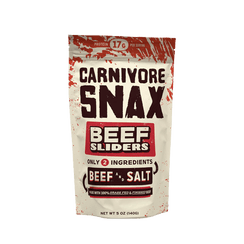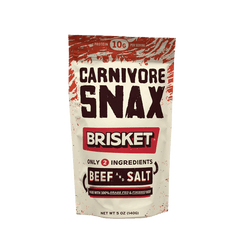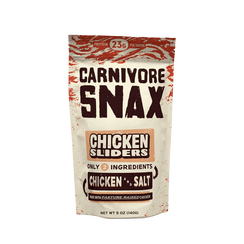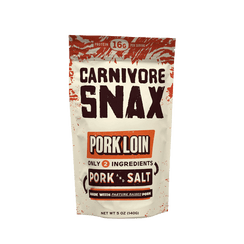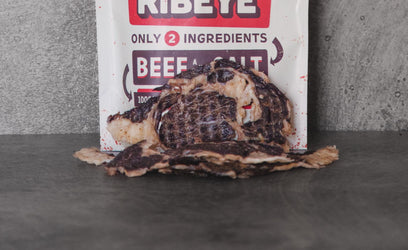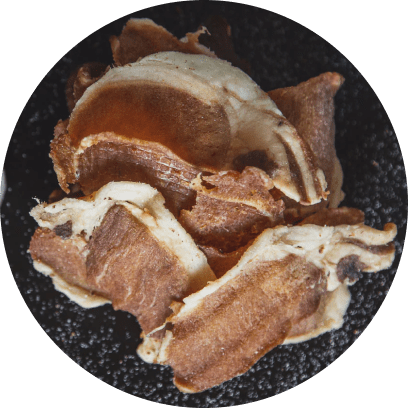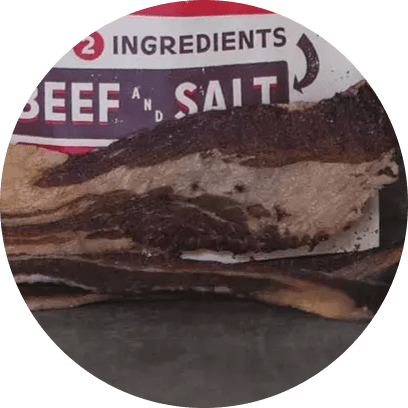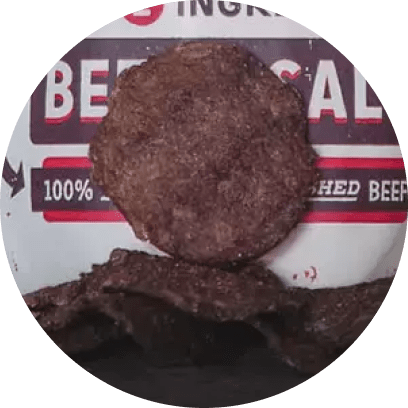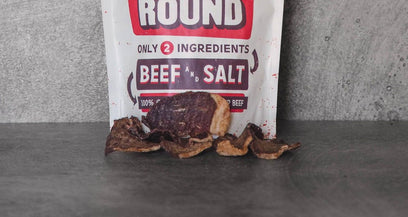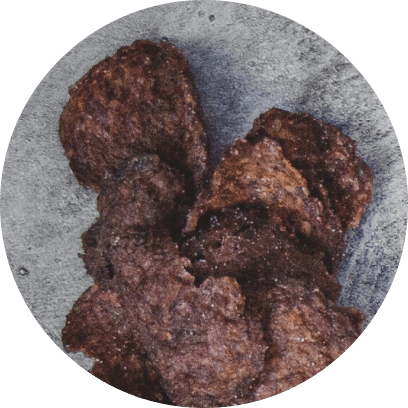THE CARNIVORE DIET BENEFITS




There's a revolution taking root in an age where every bite matters - one that will redefine your relationship with meat. If you've ever questioned where your meat comes from or wondered if there's a superior choice, then we’re eager to introduce you to regenerative agriculture meat.
Wait - what is regenerative meat?
Regenerative agriculture meat is where flavor meets ethical farming, and where nutrition goes hand-in-hand with environmental rejuvenation. We’ll cover what exactly goes into bringing this type of meat to life, why it’s superior to its conventional counterpart, and most importantly, where you can get your hands on it.
At Carnivore Snax, we've crafted regenerative meat chips that are so tantalizing, they melt in your mouth, transporting you straight to the verdant pastures where it all began. Dive in with us, and discover what truly sets regenerative meat apart.
What is Regenerative Meat?
Let’s get right into it - what is regenerative meat? To answer this question, we need to take a step back. First, what is regenerative agriculture in general?
Defining Regenerative Agriculture
Regenerative agriculture is a farming practice that goes beyond sustainability. It aims to actively rejuvenate and enhance the soil, water systems, and biodiversity of the farming environment.
Instead of merely taking from the land, regenerative agriculture gives back, ensuring that the land is healthier and more fertile for future generations.
Traditional conventional agriculture, especially on a large scale, often leans on techniques that can degrade soil quality, reduce biodiversity, and increase carbon emissions.
On the other hand, how does regenerative agriculture work? It integrates practices such as rotational grazing, cover cropping, and minimal tilling. But does regenerative agriculture really work? Yes - it sure does!
These regenerative farming methods not only sequester carbon but also promote better biodiversity, creating a balanced environment where plants and animals thrive symbiotically. Learn more about why regenerative agriculture is important in our blog.
From Pasture to Plate
So, how does this translate to the meat on your plate? What is regenerative beef?
As you may already be starting to realize, regenerative meat comes from animals raised in these dynamic ecosystems. These animals, often pasture-raised, enjoy a more natural lifestyle, foraging on diverse plants and grubs.
This not only leads to a happier and healthier animal but also results in meat that's nutritionally superior. Richer in omega-3 fatty acids, vitamins, and antioxidants, regenerative meat doesn't just taste better - it truly is better, both for you and our lands.
Furthermore, the journey of regenerative meat is one of respect and responsibility. From the moment an animal is born to the moment it reaches your plate, every step is taken with the utmost care to ensure ethical treatment and minimal environmental impact.
This is a holistic approach, ensuring that the land remains fertile, the animals live naturally, and consumers get the highest quality product.
At Carnivore Snax, our connection with regenerative meat isn't just business - it's a passion. We've seen firsthand the benefits this practice brings to the environment, to animals, and to communities. So, let’s progress this conversation and stake our claim for why regenerative agriculture meat is better.
Why Is Regenerative Agriculture Meat Better?
Have you ever bit into a piece of meat and could literally taste the difference - a burst of flavor, the right amount of juiciness, and the distinct notes of well-raised meat?
Beyond its incredible taste, regenerative agriculture meat packs a punch in numerous other ways, proving that when we care for the land, it gives back in abundance. Here are some of the regenerative agriculture benefits as it pertains to meat…
Taste the Difference
It's not just your imagination. Regenerative meat genuinely tastes better. Animals raised on regenerative farms feed on a diverse range of grasses and plants, unlike factory-farmed animals often fed a monotonous grain-based diet.
This varied diet influences the meat's flavor profile, resulting in a richer and more robust taste. Many top chefs swear by regenerative meat, claiming it offers a genuine taste of the land, a terroir if you will. Stay tuned - we’ll introduce you to the best meat snacks shortly.
Nutritional Benefits
But the advantages aren't just about taste. Regenerative meat is also a nutritional powerhouse. Animals raised in regenerative systems have been found to contain higher amounts of omega-3 fatty acids, antioxidants, and essential vitamins such as Vitamin E and B.
They have a healthier balance of omega-6 to omega-3 fats, which is beneficial for heart health and reducing inflammation in the body. When you choose regenerative, you're not just opting for flavor - you're also investing in your health.
Ethical Considerations
The term “happy mea” might sound like a marketing gimmick, but in the context of regenerative farming, it rings true. Animals are given ample space to roam, graze, and live in a way that's aligned with their natural behaviors.
This results in less stress, which not only translates to better meat quality but also ensures that the animals live a life of dignity and respect. By supporting regenerative agriculture, consumers are making an ethical choice that champions animal welfare. Learn more about regenerative cattle farming in our blog.
Restore Our Lands
Our current agricultural practices are a leading cause of land degradation. Regenerative agriculture flips this narrative on its head and works to undo the damage of modern farming.
By prioritizing soil health, increasing its water retention capacity, and promoting biodiversity, these practices actively restore our lands. In essence, by choosing regenerative meat, you're contributing to healing the planet one meal at a time.
Farmers Are Better Off, Too!
Regenerative agriculture is a boon for small-scale farmers. By shifting to these practices, farmers can increase their land's productivity, reduce their reliance on expensive synthetic fertilizers, and often fetch a premium for their produce in the market.
This means more profitability and sustainability for those who work tirelessly to put food on our tables. Learn more in our discussion of the profitability of regenerative agriculture in our blog.
Where to Buy Regenerative Meat
The movement towards regenerative agriculture and its many benefits, both for our health and the planet, has led to an increasing demand for regenerative meat. You are probably interested in following a regenerative agriculture diet yourself after discovering the benefits.
So where can you find these sustainably-raised, ethically-sourced, and delicious cuts of meat? While you may struggle to find these cuts at your local grocery store, we’ll share a few places you can look for regenerative agriculture products both locally and online. Here is where to buy regenerative meat…
Local Farmers' Markets, Butchers, and CSA Programs
More often than not, there's a hardworking farmer in your vicinity championing regenerative agricultural practices. These are the unsung heroes who prioritize soil health, animal welfare, and ecosystem balance.
By buying directly from them, not only do you get the freshest meat, but you also support local economies and foster community ties. But, where do you actually find these farmers? As the name suggests, a farmer’s market is a great starting point.
These are often goldmines for regenerative produce and meats. Farmers who attend are usually proud of their methods and will be more than willing to discuss their practices with customers. Plus, the direct interaction with the producers often ensures that you’re getting the most authentic products.
You can also check with your local butcher. Many times, these butchers pride themselves on their knowledge of their suppliers and the practices those suppliers utilize.
Or, consider exploring your local CSA (Community Supported Agriculture) program. CSAs allow individuals to invest in a farm’s operation at the beginning of the growing season and in return, receive regular boxes of fresh produce and sometimes meat.
Some CSAs have begun incorporating regenerative practices, which means that members not only get regular supplies of fresh, high-quality produce and meat, but they also have the satisfaction of knowing they’re supporting sustainable farming.
Navigating Supermarkets: How Can You Tell if Meat is Regenerative?
While supermarkets aren’t traditionally the first place you'd think of for regenerative products, the tide is turning. With increasing consumer awareness, many larger chains are starting to stock regeneratively raised meats.
One challenge in supermarkets is discerning genuine regenerative products from marketing ploys. Terms like “all-natural” or “free-range” can sometimes be misleading. Look for specifics on labels or certifications that indicate regenerative or rotational grazing practices.
Going back to the last section, larger supermarkets often employ knowledgeable butchers. Don’t hesitate to ask them about their meat's origin or the practices of their suppliers.
The Online Frontier for Regenerative Agriculture Meat
Digital platforms have become game-changers in the regenerative agriculture scene. From dedicated websites to apps, finding and ordering regenerative meat has never been easier.
Numerous online platforms now cater specifically to regenerative agriculture, shipping meat from farms that practice these methods directly to your door. They often offer a wider range than what might be available locally, especially for those in urban areas.
But, if you’re looking for some meat snacks to curb cravings on keto vs carnivore, or simply to help you eat a high protein diet without compromising on your ethics and standards, look no further than our Carnivore Chips. We offer regenerative raised meat chips that feature just 2 ingredients: meat and salt!
Our melt-in-your-mouth regenerative meat snacks are not only delicious but also ethically and sustainably sourced from the most elite farms in the country. They share our same standards for quality.
Discover the best zero-carb snacks firsthand today. Choose from ribeye chips, steak chips, lamb chips, beef chips, brisket chips, chicken chips, and pork chips today!
Bringing Our Conversation on Regenerative Agriculture Meat to a Close
The journey into the world of regenerative agriculture meat is not just about superior flavor or nutrition. It's a deep dive into ethical choices, sustainable practices, and supporting a better future for our planet.
It's about forging connections - with the earth, the farmers, and our local communities. By opting for regenerative meat, you're casting a vote for a brighter, more sustainable food system.
We have more resources like this one in our blog if you want to learn more about the history of regenerative agriculture, the pros and cons of regenerative agriculture, how to support regenerative agriculture, how to do regenerative agriculture yourself, and a whole lot more.
Just remember, every bite matters. And while our choices begin on the plate, their impact resonates far beyond. So next time your taste buds yearn for a tantalizing, mouthwatering snack, remember there's a choice that satisfies both the palate and the planet.
Dive into the world of Carnivore Snax, where flavor meets responsibility!











